Accounting for Carbon in Copenhagen | Morten Hojer
- 1. Accounting for Carbon in Copenhagen Energieffektivitet i byggeriet: xxx ICARB Conference, Edinburgh September 5 2014 Morten Hojer Climate Unit, City of Copenhagen
- 2. London School of Economics launched report on Copenhagen as a ”green economy leader” in June 2014 Is there is an economic rationale for early action on ”green” growth in cities? Source: LSE, Economics of Green Cities Programme (2011-2015). 2
- 3. The intellectual foundation of the LSE report spans across a diversity of fields (1/3) 3 1990 1995 2001 From science… … to economics 2007 2013 The Stern Review (2006) argued that the benefits of strong, early action on climate change outweigh the costs: • Without action, overall costs of climate change are equvalent to 5%-20% of world GDP each year • The impacts are irreversible and unevenly distributed; poor people in less developed countries are likely to suffer most • To avoid the worst effects of climate change about 2% of world GDP needs to be invested
- 4. The intellectual foundation of the LSE report spans across a diversity of fields (2/3) …to economics of urban agglomeration “Cities are actually the healthiest, greenest, and richest places to live. New Yorkers, for instance, live longer than other Americans; heart disease and cancer rates are lower in Gotham than in the nation as a whole. More than half of America’s income is earned in twenty-two metropolitan areas. And city dwellers use, on average, 40 percent less energy than suburbanites.” New York Times Review of Books 2011 4
- 5. The intellectual foundation of the LSE report spans across a diversity of fields (3/3) 5 … to a new ”industrial” revolution
- 6. The state of the debate Neutral Growth and climate have tradeoffs Growth and climate have co-benefits ▪ Growth model too fragile to take on climate action now ▪ High energy costs will kill growth and create competitive asymmetries ▪ Climate action puts an unfair burden on the developing world ▪ There are multiple factors which affect growth in the next 3- 5-10 years which are more important than climate action (which is frankly second-order) ▪ Higher resource efficiency can lead to better short-term growth/less volatility ▪ There are major co-benefits (air quality) ▪ Cleantech is an enormous innovation driver that will spillover positively to the whole economy Source: The Global Commission on the Economy and Climate, New Climate Economy project. 6
- 7. What is Copenhagen doing about it? Energieffektivitet i byggeriet: xxx
- 8. Over the past 20 years, Copenhagen’s economy grew by 25% while simultaneously reducing GHG emissions by 40% 8
- 9. Urban crisis and de-population followed by inner-city densification 9
- 10. Despite a low average population density, housing and employment areas have been planned with good accessibility 10
- 11. Low levels of vehicle ownership per capita 11
- 12. Low time costs of journey-to-work indicate a very effective urban transport network 12
- 13. Copenhagen carbon neutral by 2025 Energieffektivitet i byggeriet: xxx
- 14. There are big challenges… 14 • Carbon: From 20 pct to 100 pct reduction in 10 years • Population: +20 pct increase in 2025 • Housing: +25.000 new units • Office spaces: +2,8 mio. m2
- 15. … and opportunities 15
- 16. Potential emissions reductions of 1,2 mio. tons of CO2e have been identified… Energy production Energy consumption Green mobility Million tCO2e per year City administration Total Selected initiatives ▪ Biomass-based combined heat and power ▪ Land and offshore wind turbines ▪ Separation of plastics from waste ▪ Energy retrofitting of existing buildings ▪ Low-energy new build ▪ Solar PV ▪ City of Cyclists ▪ Alternative fuel vehicles (electric, hydrogen) ▪ Biogas and hybrid busses ▪ Intelligent traffic systems (ITS) ▪ Energy efficiency in own buildings ▪ New fuels in municipal vehicle fleet ▪ LED street lights New initiatives ▪ New initiatives at EU-level (energy, renewables, transport) ▪ New initiatives at national level (energy, transport) ▪ New initiatives at city-level (construction, transport) 0,9 0,1 0,1 0,1 1,2 16
- 17. … that require massive investments in Copenhagen 2013- 2025 17 Public Investments City of Copenhagen 0,4 bn€ Private Investments Direct Investments 3,25 bn€ Private Investments Energy and Climate Investments 32,8 bn€ 9 85
- 18. On the day the ”green economy” finally arrives 18
- 19. Thank you for your attention 19 MORTEN HOJER Special Advisor on Climate and Green Growth (+45) 23 39 34 43 morten.hojer@tmf.kk.dk www.kk.dk/climate and www.kk.dk/english


















